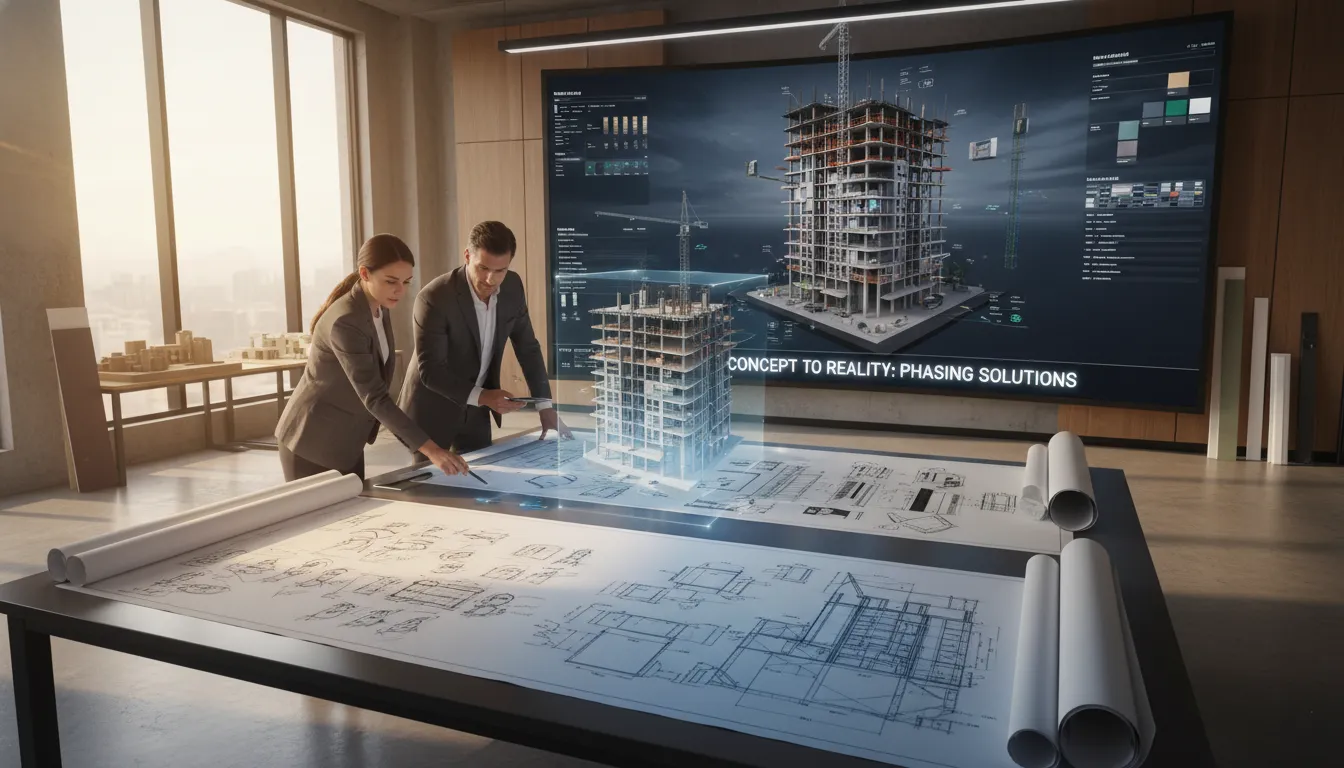Table of Contents
ToggleWhat Does “Concept to Construction” Mean?
In a traditional development process, architects create a concept, engineers refine it, and contractors interpret it. This segmented chain often leads to miscommunication, change orders, and budget overruns.
Integrated architectural design, however, merges these disciplines from day one—so every line drawn is aligned with building codes, material feasibility, and timeline expectations.
This approach empowers stakeholders to visualize their projects with clarity and make informed decisions earlier, ensuring alignment between design intent and construction practicality.
Stage 1: Conceptual Design — Turning Ideas into Vision
Every successful project begins with a solid concept. At this phase, DSS architects explore massing, volume, and functionality to express your vision within site limits and zoning codes.
We focus on spatial experiences—how people interact, how light travels, and how layouts respond to use. Concept sketches and 3D massing set the creative foundation.
Our Architectural Design process ensures early feasibility analysis. Clients see a visual representation—an idea ready to be tested against budget and local codes.
Unlike typical schematic design, every DSS concept carries the underlying promise that it’s buildable from day one.
Stage 2: Design Development — From Vision to Functionality
Once the concept matures, the design development stage introduces detailed geometry, proportions, and materials. Architects collaborate closely with structural and MEP teams to resolve systems integration.
Here, DSS’s BIM Services step in—allowing real-time coordination of disciplines in an intelligent 3D environment.
BIM models reveal how HVAC ducts align with structural framing, how electrical pathways affect ceiling design, and even how material selections influence project cost.
Coordination reduces rework, speeds up timeline forecasting, and improves communication among consultants.
For GCs, this stage is gold. With BIM-enabled coordination, they can confidently price and plan without surprises later in the field.
Stage 3: Construction Documentation — Precision Meets Reality
Design becomes actionable during Construction Documentation. DSS’s architects produce detailed floor plans, elevations, schedules, and technical specifications—turning ideas into instructions that builders can trust.
These drawings become the official language between design and construction teams.
Through 2D & 3D Floor Plan Design, we integrate both traditional linework and immersive visual presentation. It helps clients, inspectors, and investors quickly grasp spatial accuracy.
High-quality documentation also improves bidding accuracy. Contractors rely on DSS’s detailed sets to prepare realistic cost proposals, avoiding ambiguous scope definitions.
Ready to Turn Your Concept into a Constructible Reality?
Our integrated design workflow bridges imagination, budget forecasting, and city approvals. From feasibility studies to BIM coordination, DSS delivers clarity where others deliver confusion.
📞 Call +1‑215‑995‑4450 or visit designsyncstudio.com/contact-us
Stage 4: Permit Drawings — Navigating Compliance
Municipal regulations can stall any project if not properly managed. DSS supports developers through Permit Expediting Services, ensuring that drawings meet every local requirement—from accessibility and fire protection to zoning codes and sustainability ordinances.
Our team communicates directly with city reviewers, clarifying design intent and resolving discrepancies quickly. The benefit? Shorter approval windows, fewer revisions, and smoother project momentum.
Permit drawings aren’t just compliance documentation—they’re strategic roadmaps proving your project’s readiness for execution.
Stage 5: Project Estimating & Value Engineering
Great design must also be financially smart. DSS provides Accurate Construction Estimates that translate design decisions into real costs.
Using BIM data and current market pricing, our estimators deliver category-based breakdowns for materials, labor, and logistics.
This integrated estimate aligns design with affordability. Value engineering options are explored without stripping creative quality—ensuring every design outcome remains financially viable for both developers and GCs.
Stage 6: Construction Support — Adapting Design During Build
Even the best design evolves on-site. DSS supports construction teams through design clarifications, revision updates, and digital collaboration platforms. Our architects stay involved—coordinating with trades to maintain accuracy and resolve field challenges efficiently.
With integrated BIM tracking, change orders are visually documented, and version control is maintained in real-time. This results in smoother execution and fewer disputes over design intent.
The collaboration ensures every built element reflects the approved drawings—down to fixtures, finishes, and ceiling heights.

Sustainability in Integrated Design
Concept-to-construction design empowers developers to embed sustainability from the start. DSS integrates daylight studies, energy modeling, and material lifecycle analysis early in the concept stage so that efficiency becomes a natural design driver, not an afterthought.
With BIM-based simulations, we forecast energy performance, optimize HVAC loads, and minimize carbon footprint—all while maintaining aesthetics and budget priorities.
Benefits of Integrated Design for Developers & Contractors
- Clarity and Predictability: Every phase feeds directly into the next, reducing misinterpretation and eliminating rework.
- Faster Delivery: Coordinated models reduce approval delays and streamline construction schedules.
- Budget Accuracy: Real-time quantity extraction and estimation insights eliminate guesswork in tendering and procurement.
- Quality Assurance: Centralized BIM data preserves design integrity and ensures consistency across disciplines.
- Enhanced Collaboration: Architects, engineers, GCs, and developers all work from a single source of truth.
How DSS Implements Concept-to-Construction Design
DSS operates as an extension of your development team. Our workflow connects design intelligence, BIM technology, and permit management in one streamlined ecosystem. Every sketch, model, and detail serves a documented purpose—clarifying constructibility and compliance simultaneously.
We prioritize transparency, timeline communication, and client empowerment. Whether designing for mixed-use towers or residential developments, we make every project collaboration clear, precise, and efficient.
Integrating Interior Design into the Process
Beyond exterior architecture, integrated design continues inside. DSS’s Interior Design division works hand-in-hand with architectural teams to coordinate finishes, lighting, and spatial flow—ensuring interiors mirror the structural logic.
For developers, this unity boosts marketing and buyer confidence. For GCs, it means clearer contractor instructions and reduced customization conflicts.
Conclusion — The Future of Architectural Delivery
Integration is not a trend—it’s the foundation of modern project delivery. From the first visual sketch to the last permit stamp, concept-to-construction design bridges imagination and execution with data-driven precision.
For developers who value schedule integrity and cost control—and for contractors seeking transparency—working with DesignSync Studio means transforming architecture into measurable progress.
We design to build, not just to impress.
Get in touch with DSS experts to see how integrated architectural design can reshape your next project.
FAQs About Concept-to-Construction Design
1. What makes concept-to-construction design different from traditional architecture?
Traditional architecture separates creative and technical stages. Concept-to-construction integrates them—leveraging BIM and multi-disciplinary coordination so design moves smoothly from idea to execution.
2. How does DSS’s BIM approach benefit developers?
BIM allows 3D visualization, clash detection, and cost estimation within one environment. Developers gain transparency over quantity takeoffs, scenario simulations, and approval readiness.
3. Does this workflow help with faster permitting?
Yes. DSS integrates code compliance directly in design drawings, paired with Permit Expediting Services, which shortens approval durations.
4. Can it apply to small-scale or residential projects?
Absolutely. Integrated design benefits any project size—from single-family homes to commercial complexes—improving design accuracy and build predictability.
5. How can I start with DSS?
Contact DesignSync Studio today at +1-215-995-4450 or visit designsyncstudio.com/contact-us. Our team will review your project goals and outline a coordinated pathway from concept to construction.

